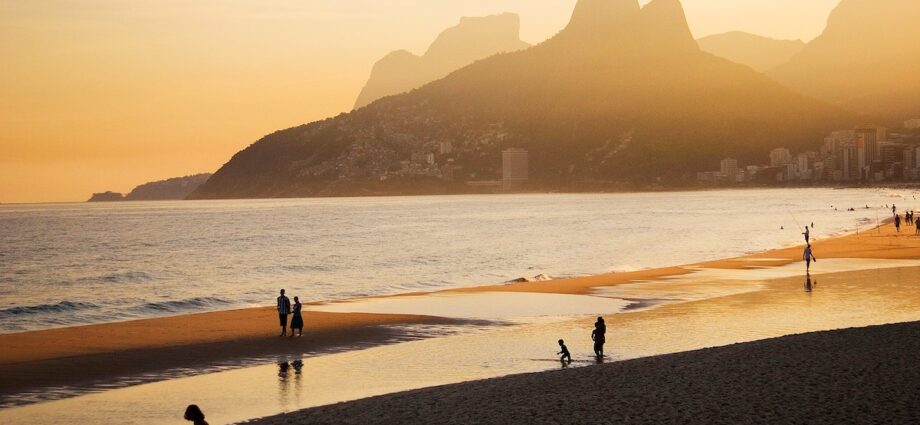This article was produced by National Geographic Traveller (UK).
On any given night in Rio de Janeiro, walk a block inland from Ipanema Beach, along Rua Vinícius de Moraes, and the sound of waves will be replaced by the soft pulse of bossa nova. The genre — downbeat samba with a hint of jazz — was made famous here in the 1960s, when Ipanema was Rio’s newest, hottest district, home to bossa king Antônio Carlos Jobim. It can be heard floating across the street from the curved terrace of bar and restaurant Vinícius, where musicians seem to serenade Ipanema itself. As locals pass below — on their way back from the beach, off to drink or shop in this most chi-chi of Rio neighbourhoods — they’re as much a part of the performance as the diners themselves.
Rio’s South Zone does beaches very well, and Ipanema’s sands — part of a two-mile arc that slowly unspools towards the twin peaks of the Dois Irmãos — are a huge part of the suburb’s appeal. ‘Ipanema’ means ‘bad water’ in the language of the Indigenous Tupi people, who first populated Brazil’s southeast coast. As a place to go fishing, they considered it poor, but, as somewhere to bask in the sunshine, this mile-long stretch of ankle-deep sand was perfect. Still, Ipanema — perched between Copacabana and Leblon — has something more. It’s a city break in itself, with cafes, markets and treasure-trove boutiques all within walking distance of sugary sands.
The Ipanema-Leblon shoreline is topped and tailed by two natural promontories connected by a seaside boardwalk. At the western end is Mirante do Leblon — a rocky lookout perched above cornflower-blue waters. Here, kiosk bar Mirante Sonhador offers freshly tapped coconuts and views of the Christ the Redeemer statue. Otherwise, seek out Sel d’Ipanema Beach Club, a craft cocktail bar on the beach. At the shore’s eastern end lies Arpoador, which divides Ipanema’s sands from Copacabana. Visitors flock to the peninsula for the sunsets — fireballs that dip between the Dois Irmãos to nightly applause. Visit in the day, and you’ll find several places to try surfing, including Arpex Surf School, which has English-speaking instructors.
‘Inland’ Ipanema is equally enticing, its streets shaded by bushy sea almond trees. The seven blocks that make up sun-dappled Rua Garcia d’Avila are filled with upmarket boutiques and restaurants set in modernist buildings. You’ll find Peruvian ceviche at La Carioca; fair-trade Bahian chocolate swirled with Amazonian cupuaçu fruit at Dengo; and toiletries scented with turmeric, black tea and Brazil nut at Granado. Around the corner is Ipanema’s main drag, Rua Visconte de Parajá, home to handbag designer Gilson Martins, whose recycled vinyl creations have been carried by the likes of Madonna and Michelle Obama.
Over at Ipanema’s eastern end, life revolves around Praça General Osório, a palm-fringed square with restaurants and bars. On Sundays, it’s filled with artisans selling handmade sandals and jewellery at the Feira Hippie (‘Hippie Market’)— founded in the 1960s when Ipanema attracted a bohemian crowd. Have lunch at Casa da Feijoada, a nearby restaurant devoted to Brazil’s national dish, feijoada.
At this point, the southernmost end of Copacabana beach is just six blocks away. Tropìk Beach Club, a boardwalk bar with slamming caipirinhas and direct access to the sand, makes an excellent vantage point. Stretching out into the sea here is another rocky peninsula: Copacabana Fort. Although military-owned, it’s open to visitors, with shady benches overlooking Copa’s swathe of pale sand. There’s also a branch of famous Rio cafe Confeiteria Colombo. Take a waterfront table at Confeitaria Colombo Café do Forte and order the Bolo Colombo, an indulgent chocolate gateau with almonds and guava. From here, you’ll see Arpoador and the tree-lined path back to Ipanema.
Published in the Jan/Feb 2025 issue of National Geographic Traveller (UK).
To subscribe to National Geographic Traveller (UK) magazine click here. (Available in select countries only).

